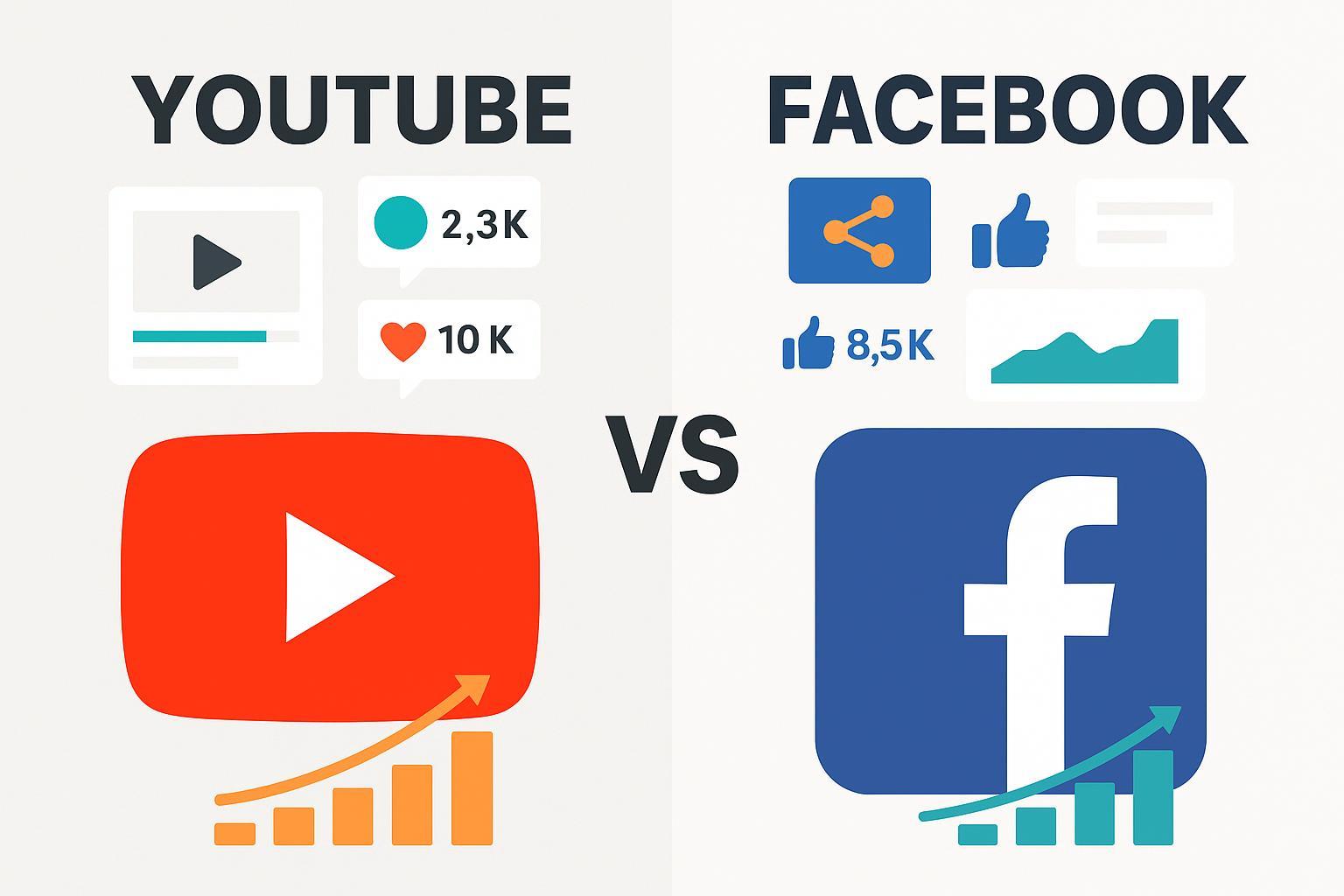YouTube vs Facebook: The Ultimate 2024 Video Engagement Platform Comparison for Creators

Choosing the right video platform is a career-defining move for creators in 2024. Whether your goal is maximizing viewer engagement, growing a sustainable audience, or earning reliable income, the competition between YouTube and Facebook shapes every strategy. This comprehensive, side-by-side analysis covers all the crucial dimensions—backed by authoritative 2024 data and direct creator feedback—to help you confidently select your best-fit platform.
Table of Contents
- Introduction: Platform Powerhouses
- Visual Comparison Table: 2024 Metrics & Features
- Dimension-by-Dimension Review
- View Count & Watch Time
- Interaction Rate (Likes, Comments, Shares)
- Audience Reach
- Monetization Options
- Content Discoverability & Algorithm
- Analytics & Reporting Tools
- Ease of Posting & Creator Workflow
- Audience Demographics
- Video Format Options
- Use Case Scenarios & Strategic Recommendations
- Conclusion: Which Platform Should Creators Choose?
- Resources & Further Reading
Introduction: Platform Powerhouses
YouTube: With 2.5 billion monthly active users (MAUs), over one billion hours watched daily, and a reputation for deep analytics and evergreen discoverability, YouTube remains the dominant long-form video and monetization platform for creators world-wide (source).
Facebook: Topping 3.07 billion MAUs globally, Facebook leverages its vast social network, rapid-fire Reels, and strong live engagement, appealing to creators aiming for viral reach and community-driven growth (source).
Visual Comparison Table: 2024 Metrics & Features
| Dimension | YouTube | |
|---|---|---|
| Monthly Active Users (MAU) | 2.5B (Statista) | 3.07B (SproutSocial) |
| Engagement Rate | 1.9% avg (long-form); Shorts industry-leading; likes, shares, comments deeply tracked | 0.12–0.08% avg (video posts, Reels); Live 3x more than carousels |
| Watch Time | 50% retention typical, 1B+ hours/day on TV; 60%+ is excellent | 50% retention (long video); 60%+ for shorts; 50% of user time is video |
| Monetization (CPM/RPM) | CPM: $5–$15 (US avg), $3 RPM (long-form), ~$0.05 RPM (Shorts) | CPM: $7–$10 (US), $1–$3 RPM typical; Stars, bonuses, branded deals |
| Revenue Stability | Stable, transparent (YouTube Partner Program, memberships, shopping, Super Chats) | Unstable; frequent changes, bonus/invite-only formats |
| Content Discoverability | Global search, trending, recommendations; evergreen & niche traffic | Viral/social algorithm; fast Reels growth, less evergreen |
| Analytics & Reporting | Deep dashboard: retention, traffic, audience, subscriber trends | Meta Suite/Studio: reach, retention, engagement (less granular) |
| Ease of Posting | Code-free, all formats, scheduling, integrated analytics | Code-free, multi-format, live, group, Reels-centric workflows |
| Audience Demographics | Youth/millennial dominant; strong in India, US, Brazil | Slightly older; global, strong US, India, APAC, lifestyle niches |
| Video Format Options | MP4/H.264, 240p–8K, landscape/portrait, Shorts, Live | MP4/MOV/GIF, 16:9–9:16, Reels, Live, Stories, 720p+ |
Dimension-by-Dimension Review
1. View Count & Watch Time
- YouTube: Exceptional daily viewing >1B hours (TV); long-form retention 50-60% typical; Shorts drive explosive quick views (source).
- Facebook: 50% of app time is video; videos often play silent, major drop-off under 10s; Reels dominate fast views but have lower retention (source).
Takeaway: YouTube leads for longer, in-depth engagement; Facebook excels at rapid short-form reach.
2. Interaction Rate (Likes, Comments, Shares)
- YouTube: Avg 1.9% interaction for standard videos; deep analytics for engagement.
- Facebook: Reels avg 0.08% engagement, regular posts 0.12%; Live video sees 3x more interactions than static posts (source).
Takeaway: YouTube delivers more predictable engagement; Facebook shines for live and fast viral sharing.
3. Audience Reach
- YouTube: Global platform; creators access international audiences, with major reach in India (476M) and US (Statista).
- Facebook: Largest total user base, strong in older/lifestyle segments; 2B users/month watch eligible video; US, India, APAC well represented.
Takeaway: Facebook is technically larger, but YouTube’s audience more often seeks video-specific content.
4. Monetization Options
- YouTube:
- AdSense revenue share (55%), memberships, Super Chats, shopping, brand deals.
- Eligibility: 1,000 subscribers + 4,000 watch hours/yr or 10M Shorts views in 90 days (YouTube Partner Program).
- CPM $5–$15 US avg, RPM ~$3 (long-form), highest CPMs in finance/gaming niches (Metricool).
- Facebook:
- In-stream ads, Reels bonuses, Stars (micropayments), branded partnerships.
- Eligibility: 5,000 followers + 60,000 watch minutes in last 60 days.
- CPM $7–$10 US avg, RPM $1–$3 typical, but revenue programs are less stable/always evolving.
Takeaway: YouTube offers greater revenue stability, higher CPM in most niches, more monetization paths; Facebook easier for quick bonus earning but less predictable long-term.
5. Content Discoverability & Algorithm
- YouTube: World-leading discoverability (search, recommendations, trending). Evergreen content continues to garner traffic for years. Algorithm favors longer retention and niche content (YouTube Algorithm Guide).
- Facebook: Feed and viral algorithms prioritize recent, socially engaging video—Reels, Live, Stories. Less emphasis on evergreen; discoverability relies on interactions/friends/groups (SproutSocial).
Takeaway: YouTube is better for content longevity and deep search; Facebook for immediate social virality.
6. Analytics & Reporting Tools
- YouTube: Industry-leading dashboard—granular retention, traffic source, subscriber introspection, advanced AI predictive analytics (YouTube Analytics).
- Facebook: Meta Business Suite & Creator Studio—reach, engagement, basic retention; improved in 2024 but less detailed than YouTube (Meta Insights).
Takeaway: YouTube provides advanced insights for optimizing content and growing sustainably.
7. Ease of Posting & Creator Workflow
- YouTube: All formats supported with code-free posting, scheduling, direct integration to analytics.
- Facebook: Multi-format workflows, easy Reels/Lives/Stories/group posting; community-focused with less technical barrier.
Takeaway: Facebook is faster for rapid posting and community engagement; YouTube is more polished for scheduled series/videos.
8. Audience Demographics
- YouTube: Dominated by youth/millennials, global diversity, top countries India, US, Brazil (Statista).
- Facebook: All ages, strong US/India presence, older skew, lifestyle/entertainment brands.
Takeaway: Match your content to platform audience—YouTube for younger/tech-focused, Facebook for broad/lifestyle.
9. Video Format Options
- YouTube: From Shorts (vertical, <60s) to 8K cinematic landscape; Live events; all major formats accepted.
- Facebook: Standard video, Reels (vertical), Live, Stories (ephemeral), viral GIFs, etc.; highly mobile-friendly.
Takeaway: Both platforms excel; choose based on your creative goals—YouTube for versatility/high production, Facebook for fast/multiple formats.
Use Case Scenarios & Strategic Recommendations
Scenario 1: Building a Sustainable Creator Career
- Best Platform: YouTube
- Why: Higher CPM, reliable monetization, evergreen content, deep analytics; slower start but long-term growth and income.
Scenario 2: Viral Growth & Fast Audience Building
- Best Platform: Facebook
- Why: Reels/Live drive rapid growth, lower barrier for quick engagement; revenue less predictable, but easier for initial traction.
Scenario 3: Niche Creators (Tech, Gaming, Education)
- Best Platform: YouTube
- Why: Niche CPMs highest; audience highly engaged over time.
Scenario 4: Lifestyle/Entertainment/Brands
- Best Platform: Facebook
- Why: Largest overall audience, high viral potential, strong for branded content partnerships and community engagement.
Scenario 5: Livestream Event Focus
- Best Platform: Facebook
- Why: Live videos see 3x median interactions and higher real-time engagement; easier multi-streaming to groups.
Conclusion: Which Platform Should Creators Choose?
YouTube is the clear winner for most creators seeking long-term stability, monetization depth, and robust analytics. If you’re working in a niche market or building evergreen educational/informative content, the platform’s algorithm and global reach amplify results over time. Monetization eligibility hurdles can be steep, but rewards are greater and more predictable.
Facebook wins for rapid audience growth, viral engagement, and multi-format posting. If your priority is building a quick following (especially in lifestyle/entertainment), leveraging community groups, or maximizing real-time interaction, Facebook’s suite of tools—particularly Reels and Live video—offer unique advantages. However, be prepared for less stable monetization and frequent program changes.
Actionable Decision Matrix: | Creator Goal | YouTube | Facebook | |-------------------------------|-------------------------|-------------------------| | Long-term monetization | ✅ Best | ❌ Unstable | | Rapid audience/viral growth | ❌ Slow | ✅ Fast | | Advanced analytics/reporting | ✅ Deep | ❌ Basic | | Brand/sponsorship potential | ✅ Strong | ✅ Strong | | Livestream engagement | ✅ Good | ✅ Best |
Pick based on your primary creator strategy—it’s not a one-size-fits-all solution!
Resources & Further Reading
- YouTube Creator Partner Program
- YouTube Analytics Overview
- Facebook Creator Monetization
- SproutSocial: Social Video Engagement Stats 2024
- Metricool: Which Social Platform Pays Most?
- Hootsuite: YouTube Algorithm Guide
For e-commerce brands and Shopify merchants seeking advanced campaign attribution and analytics, explore Attribuly: E-Commerce Marketing Analytics & Attribution.
